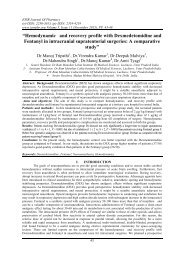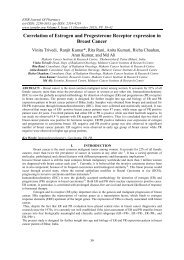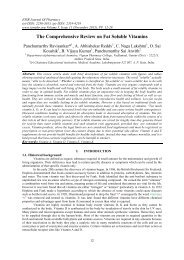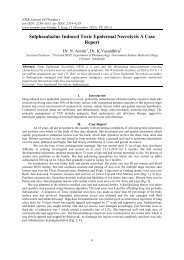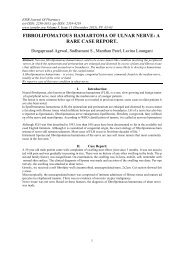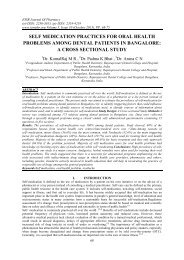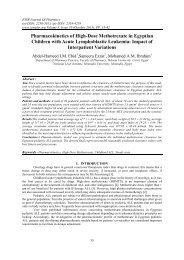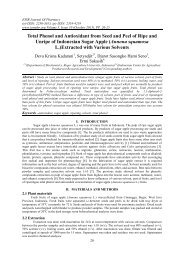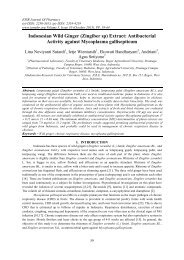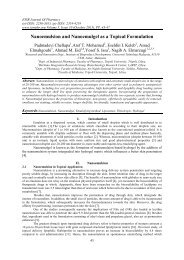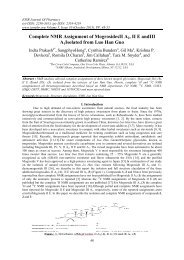Clinical manifestations, diagnosis,and treatment of Melioidosis
You also want an ePaper? Increase the reach of your titles
YUMPU automatically turns print PDFs into web optimized ePapers that Google loves.
IOSR Journal Of Pharmacy<br />
(e)-ISSN: 2250-3013, (p)-ISSN: 2319-4219<br />
www.iosrphr.org Volume 5, Issue 2 (February 2015), PP. 13-19<br />
<strong>Clinical</strong> <strong>manifestations</strong>, <strong>diagnosis</strong>,<strong>and</strong> <strong>treatment</strong> <strong>of</strong> <strong>Melioidosis</strong><br />
Murtaza Mustafa 1 Joseph, Balingi 2 ,Jayaram Menon 3 ,<br />
Fredie Robinson 4, MS.Rahman 5<br />
1,2,4,5 Faculty <strong>of</strong> Medicine, <strong>and</strong> Health Sciences,University Sabah Malaysia,Kota Kinabalu,<br />
Sabah,Malaysia.<br />
3 Department<strong>of</strong>Gasteroenterology,HospitalQueenElizabeth,Kota Kinabalu,Sabah,Malaysia.<br />
ABSTRACT: Meliodosis is endemic in Southeast Asia,northern Australia, <strong>and</strong> Brazil. Northeast Thail<strong>and</strong> has<br />
the highest incidence <strong>of</strong> melioidosis. Septicemic meliodosis has high mortality,87% in Thail<strong>and</strong>,75%in East<br />
Malaysia,39% in Singapore <strong>and</strong> 19% in Australia. Localised melioidosis has lower mortality. Burkholderia<br />
pseudomallei is found in soil <strong>and</strong> water,a history to contact with soil or surface water almost invariable with<br />
melioidosis. Diabetes mellitus, renal failure,thalassemia,haematological conditions, malignancy,steroids<br />
therapy,alcoholism <strong>and</strong> penetrating injury are the main risk factors.<strong>Clinical</strong> spectrum <strong>of</strong> melioidosis,being the<br />
fulminant end <strong>of</strong> clinical manifestation, with abscesses throughout both lungs <strong>and</strong> in in many organs.Ashdown’s<br />
medium containing gentamicin, is a selective medium for growth <strong>of</strong> B.pseudomalleui. Antibiotics <strong>of</strong> choice<br />
include, ceftazidime, imipenem for initial intensive intravenous therapy for 10 to 14 days,sulfamethoxazoletrimethoprim<br />
<strong>and</strong> doxycycline for eradication therapy for minimum 3 months.Septicemic melioidosis has high<br />
mortality, high clinical suspicion is required, <strong>and</strong> appropriate empirical antibiotic therapy should be instituted<br />
for a better outcome.<br />
KEYWORDS: <strong>Melioidosis</strong>, Burkholderia pseudomallei, Diagnosis, <strong>and</strong> Treatment<br />
I. INTRODUCTION<br />
<strong>Melioidosis</strong> is endemic in parts <strong>of</strong> southeast Asia, including,Thail<strong>and</strong>, northern Australia, <strong>and</strong> is an<br />
emerging infectious disease in Brazil, sporadic cases has been reported from other parts <strong>of</strong> the world<br />
[1,2,3]].Northeast Thail<strong>and</strong> has the highest incidence <strong>of</strong> melioidosis in the world(21.3 cases <strong>of</strong> melioidosis per<br />
100,000 people per year) [4]. <strong>Melioidosis</strong> is a recognized disease in animals,including<br />
cats,goats,sheep.horses[5].Burkholderia pseudomallei is normally found in soil <strong>and</strong> water, a history to contact<br />
with soil or surface water is, therefore, almost invariable in patients with melioidosis [6].Also implicated are<br />
severe weather events such as flooding,tsunamis, <strong>and</strong> typhoons[7,8,9].The disease is associated with rainy<br />
season, with the number(<strong>and</strong> severity) <strong>of</strong> cases.In one series <strong>of</strong> 220 cases in Sabah, Malaysia, found no seasonal<br />
variation in the occurrence <strong>of</strong> cases [10,11].The single most important risk factor for developing severe<br />
melioidosis is diabetes mellitus.Other factors include thalasaemia,haematological conditions,HBE<br />
trait,malignancy,steroids therapy, immune deficiency disease, alcoholism, drug abuse, renal<br />
disease/failure,COAD,penetrating injury, <strong>and</strong> near drowning. The mode <strong>of</strong> infection is by respiratory or<br />
cutaneous route [12,13]. <strong>Clinical</strong> presentations <strong>of</strong> melioidosis, being the fulminant end <strong>of</strong> clinical spectrum,with<br />
abscesses throughout both lungs <strong>and</strong> in in many organs[14].It has also been classified as acute, sub-acute or<br />
chronic[15].The <strong>diagnosis</strong> <strong>of</strong> the disease depends on culture <strong>of</strong> pathogen from blood,urine,<br />
sputum,pus,bronchial, bone joint aspirate.The rate <strong>of</strong> successful culture is increased if sputum, throatswabs,ulcer<br />
or skin lesions swabs, <strong>and</strong> rectal swabs are placed into Ashdown’s medium, a gentamicin- containing liquid<br />
transport broth that results in the selective growth <strong>of</strong> B.pseudomallei[16,]. B.pseudomallei can identified by<br />
combining the commercial API 20NE or 20NE biochemical kit with simple screening system involving the<br />
Gram stain, oxidasereaction, typical growth characteristics, <strong>and</strong> resistance to certain antibiotics[17].Antibiotics<br />
<strong>of</strong> choice being the β-lactam, especially ceftazidime, imipenem,meropenam,pipercillin,amoxicillinclavulanate,ceftriaxone,<strong>and</strong><br />
cefotaxime,with various degrees <strong>of</strong> bactericidal activity. Initial intensive<br />
intravenous therapy <strong>of</strong> 10 to 14 days, <strong>and</strong> eradication therapy minimum <strong>of</strong> three months or more is<br />
required[18].The paper reviews the current literature,clinical presentations, <strong>and</strong> <strong>treatment</strong> <strong>of</strong> melioidosis.<br />
II.HISTORY<br />
The name melioidosis is derived from Greek ―melis‖meaning‖a distemper <strong>of</strong> asses‖with suffixes-oid meaning<br />
―similar to‖ <strong>and</strong> –osis meaning ―a condition‖ that is, a condition similar to gl<strong>and</strong>ers[1]<strong>Melioidosis</strong> was first<br />
discovered in Burma (now Myanmar) by Whitmore <strong>and</strong> Krishmaswami in 1912.After its discovery in<br />
Burma,melioidosis was documented in humans <strong>and</strong> animals in Malaysia <strong>and</strong> Singapore from 1913 <strong>and</strong> then<br />
Vietnam from 1923 <strong>and</strong> Indonesia from 1929[19-21].Thail<strong>and</strong> had reported the highest number <strong>of</strong> cases[22-24],<br />
with an estimated 2000 to 3000 cases <strong>of</strong> melioidosis each year[25].<strong>Melioidosis</strong> is also common in Malaysia <strong>and</strong><br />
13
<strong>Clinical</strong> <strong>manifestations</strong>, <strong>diagnosis</strong>…<br />
Singapore [26-28].Other countries in the region where melioidosis is recognized in human <strong>and</strong> animals include<br />
China(especially Hong Kong), Taiwan,Brunei,Veitnam, <strong>and</strong> Laos[29-33].<strong>Melioidosis</strong> is also likely to occur in<br />
Cambodia <strong>and</strong> Philippines [21,25,34].<strong>Melioidosis</strong> has been increasingly recognized in India, although reports<br />
that some <strong>of</strong> the ―Plague‖ scares <strong>of</strong> 1994 may have been cases <strong>of</strong> melioidosis have been disapproved[35-<br />
36].Cases have been reported from Sri Lanka,Bangladesh,<strong>and</strong> Pakistan[21].Despite the early documentation <strong>of</strong><br />
melioidosis in Burma <strong>and</strong> Indonesia,recent cases had not been reported from Indonesia until after Asian<br />
tsunami[37].Cases <strong>of</strong> melioidosis have also been documented from Papua New Guinea,Fiji,<strong>and</strong> New<br />
Caledonia,but the extent <strong>of</strong> the indemnity in the Pacific isl<strong>and</strong>s remains to be defined[38].<strong>Melioidosis</strong> cases are<br />
increasingly being documented from outside the classic endemic region <strong>of</strong> Southeast Asia,Australasia,the Indian<br />
subcontinent, <strong>and</strong> China.These include sporadic human or animal cases or environmental isolates <strong>of</strong><br />
B.pseudomallei from Middle East,Africa,the carribean,<strong>and</strong> Central <strong>and</strong> South America. Although some <strong>of</strong> these<br />
reports are from incorrect species <strong>diagnosis</strong>, other are confirmed making the endemic limitations <strong>of</strong> melioidosis<br />
very unclear[21]Sporadic cases <strong>and</strong> occasional case clusters have recently occurred in Brazil <strong>and</strong> elsewhere in<br />
America[39].Despite recent cases from Madgascar,the true extent <strong>and</strong> magnitude <strong>of</strong> the presence <strong>of</strong><br />
B.pseudomallei in Africa remains entirely unknown[40].Global warming may well result in expansion <strong>of</strong><br />
endemic boundaries <strong>of</strong> melioidosis [41].<br />
The two locations where melioidosis is arguably the most important single bacterial pathogen for humans are<br />
northeast province in Thail<strong>and</strong> <strong>and</strong> the Top End <strong>of</strong> the Northern Territory <strong>of</strong> Australia. In northeast<br />
Thail<strong>and</strong>,20% <strong>of</strong> community- acquired septicemic cases are caused by melioidosis,which accounts for 39% <strong>of</strong><br />
fatal septicemias <strong>and</strong> 36% <strong>of</strong> fatal community acquired pneumonias[23,31].In the Top End <strong>of</strong> Northern<br />
Territory,melioidosis has been the most common cause <strong>of</strong> fatal community-acquired bacteremic pneumonia[42].<br />
In addition to endemic melioidosis,there are several documented situations where melioidosis became<br />
established in nontropical locations. In France, in the 1970s animals in a Paris Zoo,with spread to other Zoos<br />
<strong>and</strong> equestrian clubs[19]. In addition to fatal animal <strong>and</strong> human cases, there was extensive soil contamination<br />
persisting for some years.B.pseudomallei was considered likely to have been introduced by importation <strong>of</strong><br />
infected animals.A cluster <strong>of</strong> cases occurred over 25- year period in southwestern Westren<br />
Australia(31 o .S),involving animal cases <strong>and</strong> one human infection in a farmer. Ribotyping <strong>of</strong> farm animal <strong>and</strong><br />
human isolates <strong>and</strong> one isolate from the soil showed identical patterns [43]This supports the suggestion <strong>of</strong> clonal<br />
introduction <strong>of</strong> B.pseudomallei into this this temperate region,probably via infected animal, with environmental<br />
contamination,local dissemination <strong>and</strong> persistence over 25 years[41]. .<br />
III. PATHOGENESIS<br />
Worldwide studies have shown that most infection with B.pseudomallei is asymptomatic [44]. In<br />
northeast Thail<strong>and</strong>, most <strong>of</strong> the rural population is seropositive by indirect hemaggultination(IHA),with most<br />
seroconversion occurring between 6 months <strong>and</strong> 4 years <strong>of</strong> age[45]. Although the melioidosis occurring in all<br />
age groups, severe clinical disease such as septicemic pneumonia is seen mostly in those with risk factors such<br />
as diabetes, renal disease, <strong>and</strong> alcoholism[44]. In addition to infection by inhalation, bacterial load on exposure<br />
(inoculating dose) <strong>and</strong> virulence <strong>of</strong> the infecting strain <strong>of</strong> B.pseudomallei are also likely to influence the severity<br />
<strong>of</strong> disease. However, it has been noted that despite the large bacterial load in severely ill patients with<br />
septicemic pulmonary melioidosis, person-to-person transmission is extremely unusual. This together with rarity<br />
<strong>of</strong> fulminant melioidosis in healthy people, supports the primary importance <strong>of</strong> host risk factors for development<br />
<strong>of</strong> melioidosis. Furthermore, although it is clear from laboratory studies <strong>of</strong> isolates <strong>of</strong> B.pseudomallei from<br />
animals, humans, <strong>and</strong> the environment that virulence differs among B.pseudomallei isolates[46].the importance<br />
<strong>of</strong> this variation in virulence in determining clinical aspects <strong>of</strong> melioidosis remain unclear. Molecular typing that<br />
shows clonality <strong>of</strong> isolates in animal <strong>and</strong> human clusters has revealed that same outbreak strain can cause<br />
different clinical presentations, with host factors being most important in determining the severity <strong>of</strong> disease<br />
[47].Whole genome sequencing <strong>and</strong> subsequent molecular studies have shown that B.pseudomallei has two<br />
chrosomes, multiple genomic isl<strong>and</strong>s that are variably present in different strains <strong>and</strong> have a great propensity for<br />
horizontal gene transfer[48].Further studies are required to unravel the global phylogeny <strong>and</strong> evolutionary<br />
history <strong>of</strong> B. psedumallei <strong>and</strong> related species <strong>and</strong> to determine which genes or gene clusters may be critical for<br />
pathogenesis <strong>and</strong> disease presentation <strong>and</strong> outcome [49]. B.pseudomallei is a facultative intracellular pathogen<br />
that can invade <strong>and</strong> replicate inside various cells, including polymorphonuclear leukocytes <strong>and</strong> macrophages<br />
<strong>and</strong> some epithelial cells[50].Animal models have been unable to confirm a clinically relevant exotoxin for<br />
B.pseudomallei[51].However resistance to human serum (conferred by lipopolysaccharide[LPS])[52],<strong>and</strong> the<br />
ability <strong>of</strong> B.pseudomallei to survive intracellularly (conferred in part by capsular polysaccharide) appear to be<br />
critical in the pathogenesis <strong>of</strong> melioidosis[53-55].Type III secretion system in B.pseudomallei have also been<br />
found to be important in cell invasion <strong>and</strong> intracellular survival[56-57].<br />
14
15<br />
<strong>Clinical</strong> <strong>manifestations</strong>, <strong>diagnosis</strong>…<br />
Quorum sensing may play an important role in many aspects <strong>of</strong> virulence <strong>of</strong> B.pseudomallei including<br />
cell invasion, cytotoxicity <strong>and</strong> antimicrobial resistance[41,58-59].Other putative virulence factor c<strong>and</strong>idates<br />
include flagella, type IV pili <strong>and</strong> other adhesion, a siderophore ,<strong>and</strong> secreted proteins such as hemolysin lipases,<br />
<strong>and</strong> proteases[58]. Intracellular survival in human B.pseudomallei in human <strong>and</strong> animal hosts is likely to<br />
explain the ability for latency. After internalization, B.pseudomallei escapes from endocytic vacuoles into cell<br />
cytoplasm, <strong>and</strong> induction <strong>of</strong> actin polymerization at one bacterial pole leads to membrane protrusions, with cellto-cell<br />
spread involving these actin tails [57-59].Additional survival factors are the ability <strong>of</strong> B.pseudomallei to<br />
form antibiotic- resistant small colony variants <strong>and</strong> the ability <strong>of</strong> mucoid variants with large extracellular<br />
polysaccharide glycocalyx structures to form bi<strong>of</strong>ilm-encased micro colonies that are also relatively antibioticresistant<br />
[60]. There have been a number <strong>of</strong> studies showing elevated levels <strong>of</strong> various endogenous<br />
inflammatory mediators <strong>and</strong> cytokines to be associated with severity <strong>and</strong> outcomes <strong>of</strong> melioidosis.Nevertheless,<br />
whether these elevated cytokines are a cause or result <strong>of</strong> severe disease in not established. In Thail<strong>and</strong>, there was<br />
an association <strong>of</strong> severe melioidosis with tumor necrosis factor (TNF).-α gene allele 2, which is linked to high<br />
constitutive <strong>and</strong> inducible production <strong>of</strong> TNF-α[61]. However, in a mouse model <strong>of</strong> melioidosis,neutralization<br />
<strong>of</strong> TNF-α or interleukin(IL)-12 increased susceptibility to infection in vivo, <strong>and</strong> interferon-ᵞ (IFN-ᵞ) was found<br />
to be important for survival, with mice treated with monoclonal anti-IFN-ᵞ dying more quickly[62].<br />
A role for Toll- like receptors in the innate immune response in melioidosis has been proposed[63].There are<br />
therefore, important host protective mechanisms against B.pseudomallei in cytokine responses as well as<br />
potentially detrimental ones, with timing <strong>of</strong> cytokine release <strong>and</strong> the balance, between pro-<strong>and</strong> antiinflammatory<br />
responses likely to determine the severity <strong>of</strong> disease <strong>and</strong> outcome <strong>of</strong> infection[,58,64]The extent<br />
to which host polymorphism in immune response contribute in comparison to differences in organism virulence,<br />
infecting dose <strong>of</strong> B.pseudomallei <strong>and</strong> defined host risk factors such as diabetes remains to be<br />
clarified.Nevertheless, the predominant association with fatal melioidosis is the presence <strong>of</strong> defined patient risk<br />
factors[41].<br />
The most important risk factors are diabetes, alcohol excess <strong>and</strong> renal disease [65-67].In Thail<strong>and</strong>, the<br />
adjusted odds ratio for diabetes <strong>and</strong> renal disease (chronic renal impairment or renal or ureteric calculi) in cases<br />
<strong>of</strong> melioidosis versus controls 12.9(95% confidence interval(CI),5.1 to 37.2) <strong>and</strong>2.9(95% CI,1.7 to<br />
5.0),respectively[67].Other risk factors for melioidosis include chronic lung disease(including cystic<br />
fibrosis),thalassemia(odd ratio in Thail<strong>and</strong>,10.2;95% CI,3.5 to 30.8),malignancies, steroids therapy, iron<br />
overload, <strong>and</strong> tuberculosis[41,67]. Severe disease <strong>and</strong> fatalities are uncommon in those without risk factors, who<br />
are diagnosed <strong>and</strong> treated early, with only one death in 51 patients without risk factors in one study[41,66].Risk<br />
factors are less common in children than in adults[41,68,69]. Evidence suggests that there may be a<br />
predisposition to melioidosis in those with diabetes, alcohol excess, or chronic renal disease, which may reflect<br />
impairment <strong>of</strong> their neutrophil <strong>and</strong> other phagocytic cell functions, such as mobilization,delivery, adherence,<br />
<strong>and</strong> ingestion[66,70].<strong>Melioidosis</strong> has also been described in chronic granulomatous disease[71].<br />
IV. CLINICAL MANIFESTATIONS<br />
<strong>Clinical</strong> presentations <strong>of</strong> melioidosis has been described as the fulminant end <strong>of</strong> the clinical spectrum,<br />
with abscesses throughout both lungs, <strong>and</strong> in many organs [14]..At the other end <strong>of</strong> the spectrum are<br />
asymptomatic infections <strong>and</strong> localized skin ulcers or abscesses without systemic illness. Howe <strong>and</strong> colleagues<br />
have classified melioidosis as acute,subacute,<strong>and</strong> chronic[15].The infectious Disease Association <strong>of</strong> Thail<strong>and</strong><br />
has summarized 345 cases in these categories[41,65,22].include:(a)Multifocal infection with septicemia (45% <strong>of</strong><br />
caes,87 % mortality(b)Localized infection with septicemia (12% <strong>of</strong> cases,17% mortality)(c) Localized infection<br />
(42% <strong>of</strong> cases,9% morality)(d)Transient bacteremia (0.3%)Most recent bacteremia <strong>and</strong> overall, mortality have<br />
been respectively,60% <strong>and</strong> 49%,46% <strong>and</strong> 19% in Australia. And 43% <strong>and</strong> 39% in<br />
Singapore[41,45,66,21].Researchers in Sabah,Malaysia,reported 75% mortality in septicemic melioidosis[11].<br />
In Australia pneumonia is the commonest clinical presentation <strong>of</strong> patients with melioidosis in all studies,<br />
accounting for around half <strong>of</strong> cases. Secondary pneumonia after another primary presentation occurs in around<br />
10% <strong>of</strong> cases. Acute melioidosis pneumonia has a spectrum from fulminant septic shock) mortality up to 90%,to<br />
mild undifferentiated pneumonia, which can be acute or sub-acute in nature, with little mortality[41]. Septicemic<br />
patients present acutely unwell with high fevers <strong>and</strong> prostration <strong>and</strong> <strong>of</strong>ten little initial cough or pleuritic pain. On<br />
chest radiographs, diffuse nodular infiltrates <strong>of</strong>ten develop throughout both lungs <strong>and</strong> they coalesce, cavitate,<br />
<strong>and</strong> progress rapidly, consistent with caseous necrosis <strong>and</strong> multiple metastatic abscess formation seen at autopsy<br />
[41]. Nonsepticemic patients with pneumonia <strong>and</strong> some with septicemic pneumonia have a more predominant<br />
cough, with productive sputum <strong>and</strong> dyspnea, <strong>and</strong> their chest radiographs show discrete but progressive<br />
consolidation in one or both lobes. In endemic regions, acute pneumonia with upper lobe consolidation warrants<br />
consideration <strong>of</strong> melioidosis,although lower lobe infiltrates are also common[41].<br />
In 12% <strong>of</strong> cases in northern Australia,patients present with chronic melioidosis defined as illness with symptoms<br />
for longer than 2 months duration on presentation.Many <strong>of</strong> these patients have features mimicking tuberculosis,
16<br />
<strong>Clinical</strong> <strong>manifestations</strong>, <strong>diagnosis</strong>…<br />
with fevers, weight loss,productive cough (sometimes with hemoptysis),<strong>and</strong> classic upper lobe infiltrates, with<br />
or without cavitation on chest radiographs. In these patients, disease can be remitting <strong>and</strong> relapsing over many<br />
years, sometimes with a mis<strong>diagnosis</strong> <strong>of</strong> tuberculosis. Although acute deterioration with septicemia may occur,<br />
mortality in this group is low [41].<br />
Until recently it was thought that a colonization state did not exist for B.pseudomallei,with presence in<br />
sputum or throat always reflecting disease.However,it has recently become evident that B.pseudomallei can both<br />
colonize always <strong>and</strong> cause disease in patients with cystic fibrosis(CF) <strong>and</strong> bronchiectasis. The similarity to<br />
infection with B.cepecia complex in CF is <strong>of</strong> concern, given the association <strong>of</strong> B.cepecia complex with more<br />
rapid deterioration in lung function.Furthermore, likely transmission <strong>of</strong> B.pseudomallei between two siblings<br />
with CF has been reported[41,72]. Patients with CF traveling to melioidosis-endemic locations should be<br />
warned <strong>of</strong> the risk <strong>of</strong> melioidosis, which could be considered if they become sick after returning [41].<br />
It is common for patients to present with skin ulcers or abscesses [73].Occasionally they present with septic<br />
arthritis or osteomyelitis, or one <strong>of</strong> these can develop after the patient has presented with another primary<br />
<strong>diagnosis</strong>, usually pneumonia.Also well recognized, whatever the clinical presentation, are diseases in internal<br />
organs, especially in spleen, kidney, prostrate <strong>and</strong> liver.Where available, abdominopelvic computed tomography<br />
(CT) scanning is useful in all melioidosis patients to detect internal abscesses[41].<br />
These have been noted between Thail<strong>and</strong> <strong>and</strong> tropical Australia. First, suppurative parotitis accounts for up to<br />
40% <strong>of</strong> melioidosis in children in Thail<strong>and</strong> [68, 74],but is very rare in Australia.Second, prostrate melioidosis is<br />
well recognized but uncommon, except in Australia, where routine abdominopelvic CT scanning <strong>of</strong> all<br />
melioidosis cases has shown prostrate abscesses present in 18% <strong>of</strong> all male patients with melioidosis[66].Some<br />
were incidental in patients presenting with pneumonia or septicemia, but a primary genitourinary presentation<br />
was common with fever, abdominal discomfort, dysuria, <strong>and</strong> sometimes diarrhea <strong>and</strong> urinary retention.Third<br />
neurological melioidosis accounts for 4% <strong>of</strong> cases in northern Australia, with distinctive clinical features being<br />
brain stem encephalitis, <strong>of</strong>ten with cranial nerve palsies(especially the seventh nerve),together with peripheral<br />
motor nerve),together with peripheral motor weakness, or occasionally just flaccid paraparesis alone.The CT<br />
scan is <strong>of</strong>ten normal, but dramatic changes are seen on magnetic resonance imaging(MRI),most notably a<br />
diffusely increased T2-weighed signal in midbrain, brain stem, <strong>and</strong> spinal cord[41,75].Direct bacterial invasion<br />
<strong>of</strong> the brain <strong>and</strong> spinal cord occurs with melioidosis encephalomyelitis[41,76].<br />
Neurological melioidosis is occasionally seen outside Australia, although mostly macroscopicbrain abscesses<br />
[41, 22, 77].Unusual foci <strong>of</strong> melioidosis infection described in case reports or case series include mycolic<br />
aneurysms, lymphadenitis resembling tuberculosis, mediastinal masses, pericardial collections, <strong>and</strong> abnormal<br />
abscesses.<br />
It has long been recognized that B.pseudomallei,like tuberculosis, has the potential for reactivation<br />
from a latent focus, usually in the lung-hence the concern <strong>of</strong> the ―Vietnamese time bomb‖ in returned soldiers.<br />
Latent periods from exposure to B.pseudomallei in an endemic region to onset <strong>of</strong> melioidosis in a nonendemic<br />
region have been documented as long as 62 years [78].However, cases <strong>of</strong> reactivation B.pseudomallei appear to<br />
be very uncommon, accounting for only 3% <strong>of</strong> cases in northern Australia.The vast majority <strong>of</strong> cases <strong>of</strong><br />
melioidosis occur in the monsoonal wet seasons <strong>of</strong> various endemic regions, supporting the concept that<br />
endemic areas most patients with melioidosis have recent infections that appear with acute illness.Reactivation<br />
<strong>of</strong> melioidosis has been associated with influenza, other bacterial sepsis, <strong>and</strong> development <strong>of</strong> known melioidosis<br />
risk factors such as diabetes. It remains unknown what proportion <strong>of</strong> asymptomatic seropositive people actually<br />
have latent infection with potential for reactivation [41].<br />
V.DIAGNOSIS<br />
There are no reliable pathognomonic features <strong>of</strong> acute or sub-acute melioidosis.Other infections<br />
including tuberculosis <strong>and</strong> typhoid fever are commonly confused with melioidosis. The commonest clinical<br />
presentation <strong>of</strong> the disease in northern Australia <strong>and</strong> Southeast Asia where the infection appears to be<br />
commonest is septicemia with or without pneumonia[75].The majority <strong>of</strong> severe infections occur in patients<br />
with contributory co-morbidity such as uncontrolled diabetes mellitus, chronic renal failure,alcoholic liver<br />
disease or chronic lung disease [42].A history <strong>of</strong> contact with soil, water <strong>and</strong> percutaneous inoculation is also a<br />
risk factor <strong>of</strong> melioidosis[7].<br />
A definitive <strong>diagnosis</strong> <strong>of</strong> melioidosis requires a positive culture <strong>of</strong> B.pseudomallei. <strong>Melioidosis</strong> must be<br />
considered in a febrile patient in or returning from endemic regions to enable appropriate samples to be<br />
tested.B.pseudomallei readily grows in commercially available blood culture media,but it is not unusual for<br />
laboratorities in nonendemic locations to misidentify the bacteria as Pseudomonas species,especially because<br />
some commercial indectification syatems are poor at identifying B.pesudomalli[[79]..<br />
Culture from nonsterile sites increases the likelihood <strong>of</strong> <strong>diagnosis</strong> but can be problematic. The rate <strong>of</strong> successful<br />
culture is increased if sputum, throat swabs, ulcer or skin lesion swabs, <strong>and</strong> rectal swabs are placed into<br />
Ashdown’s medium, a gentamicin-containing liquid transport broth that results in the selective growth <strong>of</strong>
<strong>Clinical</strong> <strong>manifestations</strong>, <strong>diagnosis</strong>…<br />
B.pseudomallei[15].B.pseudomallei can identified by combining the commercial API 20NE or 20E biochemical<br />
kit with a simple screening system involving the Gram stain,oxidase reaction,typical growth characteristics, <strong>and</strong><br />
resistance to certain antibiotics[16]. There are a variety <strong>of</strong> locally developed antigen <strong>and</strong> DNA detection<br />
techniques used in endemic regions for early identification <strong>of</strong> B.pseudomallei in culture media <strong>and</strong> patient blood<br />
or urine but these are not yet widely available[16].An indirect hemaggultination test(IHA). Various enzymelinked<br />
immunosorbent assays(ELISAs),<strong>and</strong> other serological assays are available[41,80].In endemic areas,their<br />
usefulness is limited by high rates <strong>of</strong> background antibody positivity.In acute septicemic melioidosis,IHA,<strong>and</strong><br />
ELISA are <strong>of</strong>ten initially negative, but repeat testing may show seroconversion.A positive IHA,or ELISA in a<br />
tourist returning from a melioidosis –endemic region is useful in supporting the possibility <strong>of</strong> melioidosis,but<br />
definitive <strong>diagnosis</strong> still require a positive culture[80].<br />
VI.TREATMENT<br />
B.pseudomallei is characteristically resistant to penicillin,ampicillin.first-<strong>and</strong> second generation<br />
cephalosporin’s,gentamicin,tobramycin,<strong>and</strong>streotomycin.Before,1989,―conventional therapy‖ for melioidosis<br />
consisted <strong>of</strong> a combination <strong>of</strong> chloramphenicol, sulfamethoxazole-tromethoprim,doxycycline,<strong>and</strong> sometimes<br />
kanamycin, given for 6 weeks to 6 months[65].However ,there were reports <strong>of</strong> the successful use <strong>of</strong><br />
sulfametoxazole-trimethoprim alone <strong>and</strong> tetracycline or doxycycline alone.These conventional antibiotics are<br />
bacteriostatic rather than bacteriocidal,<strong>and</strong> in studies have shown various combinations to be<br />
antagonistic[41].Subsequent studies have shown B.pseudomallei to be susceptible to various Beta-lactam<br />
antibiotics ,especially, ceftazidime, imipenem, meropenem,pipercillin, amoxicillin-clavulanate,ceftriaxone,<strong>and</strong><br />
cefotaxime,with various degrees <strong>of</strong> bactericidal<br />
activity.<br />
Initial intensive therapy minimum <strong>of</strong> 10 to 14 days include ceftazidime,(50mg/kg,up to 2 g,every 6 hourly or<br />
meropenem(25mg/kg up to 1 g) every 8 hour, or imipenem(25 mg/kg up to 1 g) every 6 hour. Any one <strong>of</strong> the<br />
three may be combined with sulfamethoxazole-trimethoprim (40/8 mg/kg up to 1600/320 mg) every 12 hour<br />
(recommended for neurological,cutaneous,bone <strong>and</strong> prostatic melioidosis).<br />
Eradication therapy minimum <strong>of</strong> 3 months Sulfamethoxazole(40/8mg/kg up to 1600/320) every 12 hour with<br />
or without Doxycycline(2.5mg/kg up to 100 mg) every 12 hour[41].<br />
VII. CONCLUSION<br />
Septicemic melioidosis has high mortality, high clinical suspicion is required <strong>and</strong> appropriate empirical therapy<br />
should be instituted.<br />
REFERENCES<br />
[1]. Stanton AT,Fletcher W(1921).‖<strong>Melioidosis</strong> a new disease <strong>of</strong> the tropics:Far East Assoc <strong>of</strong> Tropi Med:transactions <strong>of</strong> the fourth<br />
Congress.Batavia,Dutch East Indies<br />
[2]. Simpson AJ,Suputtamongkol Y,Smith Mad,et al.,Clin Infect Dis.1999;29(2):381-87.<br />
[3]. Stumoller P,Kraneveld FC,Van Der Schaaf A.<strong>Melioidosis</strong>(Pseudomalleus) in sheep,goats,<strong>and</strong> pigs on Aruba(Neitherl<strong>and</strong><br />
Anitlles).J Amer vet Med Ass.1957;130:415-17.<br />
[4]. Limmathurotsakul D,Wongratanacheewin S,Teerawattanasook N.Increasing incidence <strong>of</strong> Human <strong>Melioidosis</strong> in Northeast<br />
Thail<strong>and</strong>.Am J Trop MedHyg. 2010; 82(2):1113-7.doi:10.4269ajtmh.2010.10-0038.<br />
[5]. Parkes Helen M,Shilton CM,Jerrett IV,et al.,Primary ocular melioidosis due to a single genotype <strong>of</strong> Burkholderia pseudomallei<br />
in two cats from Arnthem L<strong>and</strong> in the Northern Territory <strong>of</strong> Australia.J Feline Med Surg.2009;11(10):856-63. Doi: 10 .1016.<br />
Jfms.2009.02.009.<br />
[6]. White NJ.<strong>Melioidosis</strong>.Lancet.2003;361(9370):1715-22.Doi:10.1016?So140-6736 (03) 13374-0.<br />
[7]. Apisarnthanaarak A,KhawcharoenpomT,Mundy LM.Flood- associated melioidosis in a non-endemic region <strong>of</strong> Thail<strong>and</strong>.Int J<br />
Infect Dis.2012;16(5):e1409-10.doi: 10. 1016/Jijid.2012.01.013.<br />
[8]. Chierul W,Winothai W,Wattanawaitunechai C,et al.,<strong>Melioidosis</strong> in 6 tsunami survivors in southern Thail<strong>and</strong>.Clni Infect<br />
Dis.2005;41(7):982-90.doi:10.1086/432942.<br />
[9]. Ko WC,Cheung BM,Tang HJ,et al.,<strong>Melioidosis</strong> outbreak after typhoon,southern Taiwan.Emerg Infect Dis.2007;13(6):896-<br />
8.doi:10.3201/eid1306.o60646.<br />
[10]. Lo TJ,Ang IW,James I,et al.,<strong>Melioidosis</strong> in a Tropical City State, Singapore. 2009;Emerg Infect Dis.15(10)1645-<br />
7.doi:10.3201.eid1510.090246.<br />
[11]. Mustafa M,Jayaram Menon.Epidemiology <strong>of</strong> Burkholderia Pseudomallei infections in a Malaysian hospital.2002;.Sci<br />
Int(Lahore)14(3):247-50.<br />
[12]. Suputtamongkol Y,Chaowagul W,Chetchotisakd P,et al.,Risk factors for melioidosis <strong>and</strong> bacteremic melioidosis.Clin Infect<br />
Dis.1999;29(2):408-13.doi:10.1086/520223.<br />
[13]. Mustafa M,Jayaram Menon.<strong>Melioidosis</strong>:<strong>Clinical</strong> presentation in Sabah,Malaysia.Sci Int(Lahore).2004;16(1):39-41.<br />
[14]. Whitmore A,Krishnaswami CS.An account <strong>of</strong> the discovery <strong>of</strong> a hitherto undescribed infective disease occurring among<br />
population <strong>of</strong> Rangoon.Indian Med Gaz. 1912; 47: 262-67.<br />
[15]. Howe C,Sampath A,Spotnitz M.The pseudomallei group:A review.J Infect Dis. 1971; 124:598-606.<br />
[16]. Ashdown IR.An improved screening technique for isolation <strong>of</strong> Pseudomonaspseudomallei from clinical<br />
specimens.Pathology.1979;11:293-97.<br />
17
<strong>Clinical</strong> <strong>manifestations</strong>, <strong>diagnosis</strong>…<br />
[17]. Dance DA,Wuthiekanun V,Naigwit R,et al.,Identification <strong>of</strong> Pseudomonas pseudomallei in clinical practice:Use <strong>of</strong> simple<br />
screening test <strong>and</strong> API 20NE.J ClinPathol.1989;42:645-48.<br />
[18]. Phetsouvanh R,Phongmany S,Soukloun D,et al.Causes <strong>of</strong> community- acquired bacteremia <strong>and</strong> pattern <strong>of</strong> antimicrobial<br />
resistance in Vientiane,Laos.Am J Trop MedHyg.2006;75:978-85<br />
[19]. Dance DA. <strong>Melioidosis</strong>: The tip <strong>of</strong> the iceberg? Clin MicrobiolRev. 1991;4:52-60.<br />
[20]. White NJ. <strong>Melioidosis</strong>. Lancet. 2003;361:1715-1722.<br />
[21]. Cheng AC, Currie BJ. <strong>Melioidosis</strong>: epidemiology, pathophysiology, <strong>and</strong> management. Clin Microbiol Rev. 2005;18:383-416.<br />
[22]. Punyagupta S. <strong>Melioidosis</strong>: Review <strong>of</strong> 686 cases <strong>and</strong> presentation <strong>of</strong> a new clinical classification. In: Punyagupta Sirisanthana<br />
T, Stapatayavong B, eds. <strong>Melioidosis</strong>. Bangkok: Bangkok Medical; 1989:217-229.<br />
[23]. Chaowagul W, White NJ, Dance DA, et al. <strong>Melioidosis</strong>: A major cause <strong>of</strong> community-acquired septicemia in northeastern<br />
Thail<strong>and</strong>.J Infect Dis. 1989;159:890-899.<br />
[24]. Vuddhakul V, Tharavichitkul P, Na-Ngam N, et al. Epidemiology <strong>of</strong> Burkholderia pseudomallei in Thail<strong>and</strong>. Am J Trop<br />
MedHyg. 1999;60:458-461.<br />
[25]. Leelarasamee A. <strong>Melioidosis</strong> in Southeast Asia. Acta Trop.2000; 74:129-132.<br />
[26]. Puthucheary SD, Parasakthi N, Lee MK. Septicaemic melioidosis: A review <strong>of</strong> 50 cases from Malaysia. Trans R Soc Trop<br />
MedHyg. 1992;86:683-685.<br />
[27]. Yap EH, Chan YC, Goh KT, et al. Sudden unexplained death syndrome—a new manifestation in melioidosis? EpidemiolInfect.<br />
1991;107:577-584.<br />
[28]. Liu Y, Loh JP, Aw LT, et al. Rapid molecular typing <strong>of</strong> Burkholderia pseudomallei, isolated in an outbreak <strong>of</strong> melioidosis in<br />
Singaporein 2004, based on variable-number t<strong>and</strong>em repeatsTrans R Soc Trop Med Hyg. 2006;100:687-692.<br />
[29]. Dance DA. <strong>Melioidosis</strong> as an emerging global problem. Acta Trop. 2000;74:115-119.<br />
[30]. Lee N, Wu JL, Lee CH, et al. Pseudomonas pseudomallei infection from drowning: The first reported case in Taiwan. J Clin<br />
Microbiol. 1985;22:352-354.<br />
[31]. Hsueh PR, Teng LJ, Lee LN, et al. <strong>Melioidosis</strong>: An emerginginfection in Taiwan? Emerg Infect Dis. 2001;7:428-433.<br />
[32]. Parry CM, Wuthiekanun V, Hoa NT, et al. <strong>Melioidosis</strong> in Southern Vietnam: <strong>Clinical</strong> surveillance <strong>and</strong> environmental<br />
sampling.Clin Infect Dis. 1999;29:1323-1326.<br />
[33]. Phetsouvanh R, Phongmany S, Soukaloun D, et al. Causes <strong>of</strong> community-acquired bacteremia <strong>and</strong> patterns <strong>of</strong> antimicrobial<br />
resistance in Vientiane, Laos. Am J Trop Med Hyg. 2006;75:978- 985.<br />
[34]. Wuthiekanun V, Pheaktra N, Putchhat H, et al. Burkholderia pseudomallei antibodies in children, Cambodia. Emerg<br />
InfectDis. 2008;14:301-303.<br />
[35]. Cherian T, Raghupathy P, John TJ. Plague in India. Lancet. 1995;345:258-259.<br />
[36]. Dance DA, S<strong>and</strong>ers D, Pitt TL, et al. Burkholderia pseudomallei<strong>and</strong> Indian plague-like illness. Lancet. 1995;346:904-905.<br />
[37]. Athan E, Allworth AM, Engler C, et al. <strong>Melioidosis</strong> in tsunami survivors. Emerg Infect Dis. 2005;11:1638-1639.<br />
[38]. Le Hello S, Currie BJ, Godoy D, et al. <strong>Melioidosis</strong> in New Caledonia. Emerg Infect Dis. 2005;11:1607-1609.<br />
[39]. Inglis TJ, Rolim DB, Sousa Ade Q. <strong>Melioidosis</strong> in the Americas. Am J Trop Med Hyg. 2006;75:947-954.<br />
[40]. Borgherini GP, Poubeau F, Paganin S, et al. <strong>Melioidosis</strong>: an imported case from Madagascar. J Travel Med. 2006;13:318-320.<br />
[41]. Curries BJ.Burkholderia pseudomallei <strong>and</strong> Burkholderia mallei:<strong>Melioidosis</strong> <strong>and</strong> Gl<strong>and</strong>ers.In:M<strong>and</strong>el Douglas <strong>and</strong> Burnnett’s<br />
Principles <strong>and</strong> Practice <strong>of</strong> Infectious Diseases, 7 th Ed.M<strong>and</strong>ell GLBennett JE,Dolin R(editors).Churchill Livingstone Elsevier,<br />
2010.<br />
[42]. Currie BJ, Fisher DA, Howard DM, et al. The epidemiology <strong>of</strong> melioidosis in Australia <strong>and</strong> Papua New Guinea. Acta<br />
Trop.2000;74:121-127.<br />
[43]. Currie B, Smith Vaughan H, Golledge C, et al. Pseudomonas pseudomallei isolates collected over 25 years from a nontropicalendemic<br />
focus show clonality on the basis <strong>of</strong> ribotyping. Epidemiol Infect. 1994;113:307-312.44.<br />
[44]. Wuthiekanun V, Chierakul W, Langa S, et al. Development <strong>of</strong>antibodies to Burkholderia pseudomallei during childhood<br />
inmelioidosis-endemic northeast Thail<strong>and</strong>. Am J Trop Med Hyg.2006;74:1074-1075.<br />
[45]. Suputtamongkol Y, Hall AJ, Dance DA, et al. The epidemiology <strong>of</strong> melioidosis in Ubon Ratchatani, northeast Thail<strong>and</strong>. Int J<br />
Epidemiol. 1994;23:1082-1090.<br />
[46]. Ulett GC, Currie BJ, Clair TW, et al. Burkholderia pseudomallei virulence: Definition, stability <strong>and</strong> association with<br />
clonality.Microbes Infect. 2001;3:621-631.<br />
[47]. Currie BJ, Mayo M, Anstey NM, et al. A cluster <strong>of</strong> melioidosis cases from an endemic region is clonal <strong>and</strong> is linked to the water<br />
supply using molecular typing <strong>of</strong> Burkholderia pseudomallei isolates. Am J Trop Med Hyg. 2001;65:177-179.<br />
[48]. Holden MT, Titball RW, Peacock SJ, et al. Genomic plasticity <strong>of</strong> the causative agent <strong>of</strong> melioidosis, Burkholderia pseudomallei.<br />
Proc Natl Acad Sci U S A. 2004;101:14240-45.<br />
[49]. Tuanyok A, Auerbach RK, Brettin TS, et al. A horizontal gene transfer event defines two distinct groups within<br />
Burkholderiapseudomallei that have dissimilar geographic distributions. JBacteriol. 2007;189:9044-9049.<br />
[50]. Egan AM, Gordon DL. Burkholderia pseudomallei activates complement <strong>and</strong> is ingested but not killed by polymorphonuclear<br />
leukocytes. Infect Immun. 1996;64:4952-59.<br />
[51]. Brett PJ, Woods DE. Pathogenesis <strong>of</strong> <strong>and</strong> immunity to melioidosis. Acta Trop. 2000;74:201-210.<br />
[52]. DeShazer D, Brett PJ, Woods DE. The type II O-antigenic polysaccharidemoiety <strong>of</strong> Burkholderia pseudomallei<br />
lipopolysaccharide is required for serum resistance <strong>and</strong> virulence. MolMicrobiol. 1998;30:1081-1100.<br />
[53]. Reckseidler SL, DeShazer D, Sokol PA, et al. Detection <strong>of</strong> bacterial virulence genes by subtractive hybridization: identification<br />
<strong>of</strong> capsular polysaccharide <strong>of</strong> Burkholderia pseudomallei as amajor virulence determinant. Infect Immun. 2001;69:34-44.<br />
[54]. Woods DE. The use <strong>of</strong> animal infection models to study the pathogenesis <strong>of</strong> melioidosis <strong>and</strong> gl<strong>and</strong>ers. Trends Microbiol. 2002;<br />
11:483-484.<br />
[55]. DeShazer D, Waag DM, Fritz DL, et al. Identification <strong>of</strong> a Burkholderia mallei polysaccharide gene cluster by<br />
subtractivehybridization <strong>and</strong> demonstration that the encoded capsule is anessential virulence determinant. Microb Pathog.<br />
2001;30:253 269.<br />
[56]. Winstanley C, Hart CA. Presence <strong>of</strong> type III secretion genes in Burkholderia pseudomallei correlates with Ara − phenotypes. JClin<br />
Microbiol. 2000;38:883-885.<br />
[57]. Stevens MP, Wood MW, Taylor LA, et al. An Inv/Mxi-Spa-like type III protein secretion system in Burkholderia pseudomallei<br />
modulates intracellular behaviour <strong>of</strong> the pathogen. Mol Microbiol. 2002;46:649-659.<br />
[58]. Wiersinga WJ, van der Poll T, White NJ, et al. <strong>Melioidosis</strong>: Insights into the pathogenicity <strong>of</strong> Burkholderia pseudomallei.<br />
NatRev Microbiol. 2006;4:272-282.<br />
18
<strong>Clinical</strong> <strong>manifestations</strong>, <strong>diagnosis</strong>…<br />
[59]. Stevens MP, Stevens JM, Jeng RL, et al. Identification <strong>of</strong> a bacterialfactor required for actin-based motility <strong>of</strong><br />
Burkholderiapseudomallei. Mol Microbiol. 2005;56:40-53.<br />
[60]. Haussler S, Rohde M, Steinmetz I. Highly resistant Burkholderia pseudomallei small colony variants isolated in vitro <strong>and</strong><br />
inexperimental melioidosis. Med Microbiol Immunol (Berl).1999;188:91-97.<br />
[61]. Nuntayanuwat S, Dharakul T, Chaowagul W, et al. Polymorphism in the promoter region <strong>of</strong> tumor necrosis factor-alphagene is<br />
associated with severe melioidosis. Hum Immunol.1999;60:979-983.<br />
[62]. Santanir<strong>and</strong> P, Harley VS, Dance DA, et al. Obligatory role <strong>of</strong> gamma interferon for host survival in a murine model <strong>of</strong><br />
infectionwith Burkholderia pseudomallei. Infect Immun. 1999;67:3593-3600.<br />
[63]. Wiersinga WJ, Wiel<strong>and</strong> CW, Dessing MC, et al. Toll-like receptor 2 impairs host defense in gram-negative sepsis causedby<br />
Burkholderia pseudomallei (melioidosis). PLoS Med.2007;4:e248.<br />
[64]. Wiersinga WJ, Dessing MC, Kager PA, et al. High-throughput mRNA pr<strong>of</strong>iling characterizes the expression <strong>of</strong><br />
inflammatorymolecules in sepsis caused by Burkholderia pseudomallei. InfectImmun. 2007;75:3074-3079.<br />
[65]. Leelarasamee A, Bovornkitti S. <strong>Melioidosis</strong>: Review <strong>and</strong> update. Rev Infect Dis. 1989;11:413-425.<br />
[66]. Currie BJ, Fisher DA, Howard DM, et al. Endemic melioidosis in tropical northern Australia: A 10-year prospective study<br />
<strong>and</strong>review <strong>of</strong> the literature. Clin Infect Dis. 2000;31:981-986.<br />
[67]. Suputtamongkol Y, Chaowagul W, Chetchotisakd P, et al. Risk factors for melioidosis <strong>and</strong> bacteremic melioidosis. Clin<br />
InfectDis. 1999;29:408-413.<br />
[68]. Lumbiganon P, Viengnondha S. <strong>Clinical</strong> <strong>manifestations</strong> <strong>of</strong> melioidosis in children. Pediatr Infect Dis J. 1995;14:136-140.<br />
[69]. Edmond K, Bauert P, Currie B. Paediatric melioidosis in the Northern Territory <strong>of</strong> Australia: An exp<strong>and</strong>ing clinical spectrum. J<br />
Paediatr Child Health. 2001;37:337-341.<br />
[70]. Easton A, Haque A, Chu K, et al. A critical role for neutrophils in resistance to experimental infection with Burkholderia<br />
pseudomallei. J Infect Dis. 2007;195:99-107<br />
[71]. Tarlow MJ, Lloyd J. <strong>Melioidosis</strong> <strong>and</strong> chronic granulomatous disease. Proc R Soc Med. 1971;64:19-20.<br />
[72]. Holl<strong>and</strong> DJ, Wesley A, Drinkovic D, et al. Cystic fibrosis <strong>and</strong> Burkholderia pseudomallei: An emerging problem? Clin<br />
InfectDis. 2002;35:e138-140.<br />
[73]. Gibney KB, Cheng AC, Currie BJ. Cutaneous melioidosis in the tropical top end <strong>of</strong> Australia: a prospective study <strong>and</strong> review <strong>of</strong><br />
the literature. Clin Infect Dis. 2008;47:603-609.<br />
[74]. Dance DA, Davis TM, Wattanagoon Y, et al. Acute suppurative parotitis caused by Pseudomonas pseudomallei in children.<br />
JInfect Dis. 1989;159:654-660.<br />
[75]. Currie BJ, Fisher DA, Howard DM, et al. Neurological melioidosis. Acta Trop. 2000;74:145-151.<br />
[76]. Koszyca B, Currie BJ, Blumbergs PC. The neuropathology <strong>of</strong> melioidosis: two cases <strong>and</strong> a review <strong>of</strong> the literature. Clin<br />
Neuropathol.2004;23:195-203.<br />
[77]. Chadwick DR, Ang B, Sitoh YY, et al. Cerebral melioidosis in Singapore: A review <strong>of</strong> five cases. Trans R Soc Trop Med Hyg.<br />
2002;96:72-76.<br />
[78]. Ngauy V,Lmeshev Y,Sadllowski I,et al.Cutaneous melioidosis in a man who was takenas prisoner <strong>of</strong> war by the Japanese during<br />
World War II.Clin Microbiol.2005;43:970-72.<br />
[79]. Lowe P, Engler C, Norton R. Comparison <strong>of</strong> automated <strong>and</strong> nonautomated systems for identification <strong>of</strong> Burkholderia<br />
pseudomallei. J Clin Microbiol. 2002;40:4625-4627.<br />
[80]. Sirisinha S, Anuntagool N, Dharakul T, et al. Recent developments in laboratory <strong>diagnosis</strong> <strong>of</strong> melioidosis. Acta Trop.<br />
2000;74:235-245.<br />
19




